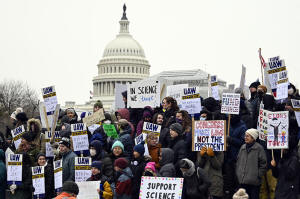Huge cuts in National Institutes of Health research funding go before a
federal judge
 Send a link to a friend
Send a link to a friend
 [February 21, 2025]
By LAURAN NEERGAARD and MICHAEL CASEY [February 21, 2025]
By LAURAN NEERGAARD and MICHAEL CASEY
BOSTON (AP) — A court battle is set to resume Friday over the Trump
administration’s drastic cuts in medical research funding that many
scientists say will endanger patients and delay new lifesaving
discoveries.
A federal judge in Massachusetts temporarily blocked the cuts from
taking effect earlier this month in response to separate lawsuits filed
by a group of 22 states plus organizations representing universities,
hospitals and research institutions nationwide.
The new National Institutes of Health policy would strip research groups
of hundreds of millions of dollars to cover so-called indirect expenses
of studying Alzheimer's, cancer, heart disease and a host of other
illnesses — anything from clinical trials of new treatments to basic lab
research that is the foundation for discoveries. Now U.S. District Judge
Angel Kelley, who was appointed by Democratic President Joe Biden, must
decide whether to extend the temporary restraining order blocking those
cuts.
The states and research groups say such a move is illegal, pointing to
bipartisan congressional action during President Donald Trump’s first
term to prohibit it.
“Yet here we are again,” attorneys argued in a court motion, saying the
NIH is “in open defiance” of what Congress decreed.
In its own written arguments, the Trump administration said NIH has
authority to alter the terms after awarding grants and that Kelley’s
courtroom isn’t the proper venue to arbitrate claims of breach of
contract.

States and researchers “have failed to show that they would suffer an
irreparable injury,” according to the administration motion.
The NIH, the main funder of biomedical research, awarded more than
60,000 grants last year totaling about $35 billion. The total is divided
into "direct" costs – covering researchers’ salaries and laboratory
supplies – and “indirect” costs, the administrative and facility costs
needed to support that work.
The Trump administration had dismissed those expenses as “overhead” but
universities and hospitals argue they’re far more critical. They can
include such things as electricity to operate sophisticated machinery,
hazardous waste disposal, staff who ensure researchers follow safety
rules and janitorial workers.
[to top of second column]
|

Medical researchers from universities and the National Institutes of
Health rally near the Health and Human Services headquarters to
protest federal budget cuts Wednesday, Feb. 19, 2025, in Washington.
(AP Photo/John McDonnell)
 Different projects require different
resources. Labs that handle dangerous viruses, for example, require
more expensive safety precautions than a simpler experiment. So
currently each grant’s amount of indirect costs is negotiated with
NIH, some of them small while others reaching 50% or more of the
total grant.
If the new policy stands, indirect costs would be capped at 15%
immediately, for already awarded grants and new ones. NIH calculated
that would save the agency $4 billion a year.
A motion filed earlier this week cited a long list of examples of
immediate harm in blue states and red states. They included the
possibility of ending some clinical trials of treatments at the
University of Wisconsin, Madison, that could leave “a population of
patients with no viable alternative."
Officials at Johns Hopkins University were more blunt, saying the
cut would end or require significantly scaling back research
projects potentially including some of the 600 NIH-funded studies
open to Hopkins patients.
“The care, treatments and medical breakthroughs provided to them and
their families are not ‘overhead,’” university president Ron Daniels
and Hopkins Medicine CEO Theodore DeWeese wrote to employees.
Attorneys also argued the cuts would harm state economies. The
University of Florida would need to cut “critical research staffing”
by about 45 people, while construction of a new research facility in
Detroit expected to create nearly 500 new jobs could be paused or
even abandoned, they wrote.
“Implementing this 15% cap will mean the abrupt loss of hundreds of
millions of dollars that are already committed to employing tens of
thousands of researchers and other workers, putting a halt to
countless lifesaving health research and cutting-edge technology
initiatives,” the lawsuit said.
___
Neergaard reported from Washington.
All contents © copyright 2025 Associated Press. All rights reserved |